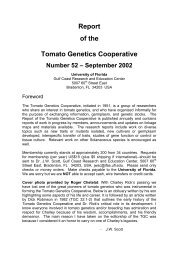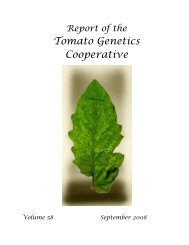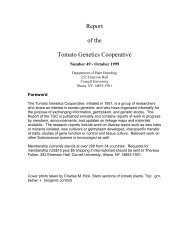Volume 60 - Tomato Genetics Cooperative - University of Florida
Volume 60 - Tomato Genetics Cooperative - University of Florida
Volume 60 - Tomato Genetics Cooperative - University of Florida
Create successful ePaper yourself
Turn your PDF publications into a flip-book with our unique Google optimized e-Paper software.
esistance, and breeding in geographical areas where different strains <strong>of</strong> bacterial wilt<br />
are prevalent, the breeders exploited the genetic potentialities at their disposal, and<br />
created material resisting a wide range <strong>of</strong> bacterial wilt strains as exemplified by the<br />
results obtained in the worldwide trial carried out by Wang et al. (1998). Indeed, the top<br />
nine resistant accessions which had high levels <strong>of</strong> resistance in almost all 12 locations<br />
tested (>90% survival on average) were developed in Hawaii („H7996‟, „H7997 S and<br />
L‟, „H7998 S and M‟), Philippines („TML46‟ and „TML114‟, „R3034‟), and Japan („BF-<br />
Okitsu‟).<br />
Other sources <strong>of</strong> resistance in wild tomatoes have been described sporadically in<br />
the literature in accessions <strong>of</strong> the same species (S. pimpinellifolium, cherry and pear S.<br />
lycopersicum) as well as in other wild relatives <strong>of</strong> tomato (Laterrot & Kaan, 1977;<br />
Jaworski et al., 1987; Anaïs, 1997; Mohamed et al., 1997; Carmeille et al. 2006b; Hai et<br />
al., 2008). From these results, it seems that resistance to bacterial wilt is not that<br />
frequent in tomato germplasm. The high genetic diversity displayed by Ralstonia<br />
solanacearum complex (Fegan & Prior, 2005) and the strong interactions between<br />
strains and resistant material (Lebeau et al., 2011) suggest that various resistance<br />
mechanisms, including strain specific ones, exist in tomato resistant germplasm.<br />
Therefore, breeders have some opportunities at their disposal to enlarge the relatively<br />
narrow range <strong>of</strong> resistance sources primarily used so far, and to continue accumulating<br />
different mechanisms <strong>of</strong> resistance in tomato genotypes to obtain better stability <strong>of</strong><br />
resistance in different environments. However, they might be limited by the fact that<br />
some bacterial strains are not controlled by any resistant accession (see section 5.<br />
below).<br />
Inheritance studies have focused mostly on F2, F3 and RILs progenies <strong>of</strong> „Hawaii<br />
7996‟ crossed with the susceptible „WVa700‟ (S. pimpinellifolium). Several QTLs <strong>of</strong><br />
resistance have been identified, including a major QTL on chromosome 6 effective<br />
towards „GMI8217‟, an isolate <strong>of</strong> race 1 biovar 1 (Thoquet et al. 1996a & b); <strong>of</strong> „Pss4‟,<br />
an isolate <strong>of</strong> race 1, biovar 3, phylotype 1 (Wang et al., 1998); and „JT516‟, an isolate<br />
representative <strong>of</strong> race 3-phylotype II (Carmeille et al., 2006a). Wang et al. (2000)<br />
identified another major QTL <strong>of</strong> resistance <strong>of</strong> „Hawaii 7996‟ effective towards „Pss4‟ and<br />
located on chromosome 12. Several minor QTLs located on chromosomes 3, 4, 8,<br />
some <strong>of</strong> which having a season dependent expression (Carmeille et al., 2006a) have<br />
also been identified. Mejia et al (2009) confirmed the QTLs on chromosome 6 and 12<br />
were associated with resistance in „Hawaii 7996‟ observed in Guatemala field evaluation<br />
against local phylotype I strains. Work is ongoing at AVRDC for adding markers to the<br />
QTLs regions <strong>of</strong> „Hawaii 7996‟ associated to resistance to bacterial strains belonging to<br />
phylotype I, in order to develop tools for marker assisted selection.<br />
QTLs <strong>of</strong> resistance <strong>of</strong> the resistant line „L285‟ effective towards „UW364‟ an isolate<br />
<strong>of</strong> race 1, biovar 4, have also been located on chromosomes 6, as well as on<br />
chromosomes 7 and 10 (Danesh et al., 1994). Pattern <strong>of</strong> resistance derived from<br />
CRA66 has been described as polygenic (Prior et al., 1994) but no molecular data are<br />
available for this source.<br />
15





